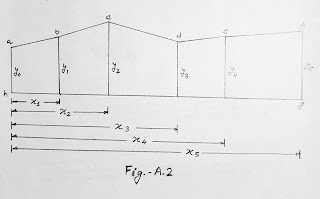COMPUTATION OF AREA AND VOLUME
AREAS
The
method of computation of area depends upon the shape of the boundary of the
tract and accuracy required. The area of the tract of the land is computed from
its plan which may be enclosed by straight, irregular or combination of
straight and irregular boundaries. When the boundaries
are
straight the area is determined by subdividing the plan into simple geometrical
figures such as triangles, rectangles, trapezoids, etc. For irregular
boundaries, they are replaced by short straight boundaries, and the area is
computed using approximate methods or Planimeter when the boundaries are very
irregular. Standard expressions as given below are available for the areas of
straight figures.
Area
of triangle = ½absinθ
Or
Area
of triangle = √{s(s-a)(s-b)(s-c)}
Area
of triangle = ½ x b x h
Area Enclosed by Irregular
Boundaries
Two fundamental rules exist for the determination of areas of irregular figures as shown in Fig A.1. These rules are (i) Trapezoidal rule and (ii) Simpson's rule.
Trapezoidal Rule
In
trapezoidal rule, the area is divided into a number of trapezoids, boundaries
being assumed to be straight between pairs of offsets. The area of each
trapezoid is determined and added together to derive the whole area. If there
are n offsets at equal interval of d then the total area is
A = d( O₁+On + O₂+ O₃
+ ......... + On-₁)
2
Simpson's Rule
In
Simpson's rule it is assumed that the irregular boundary is made up of parabolic
arcs. The areas of the successive pairs of intercepts are added together to get
the total area.
A = d[(O₁+On) + 4(O₂+O₄+.......+ On-₂) + 2(O₃+O₅+.......
+ On-₁)]
3
3
+2(Sum of Odd Ordinates)]
Since
pairs of intercepts are taken, it will be evident that the number of intercepts
n is even. If n is odd then the first or last intercept is
treated as a trapezoid.
Coordinate Method of Finding Area.
Procedure
From
the given distances and offsets, appoint is selected as the origin in Fig A.2.
Taking h as the origin, the coordinates of
all other points are arranged as follows.
|
Points |
Coordinates |
|
|
X |
Y |
|
|
a |
0 |
y₀ |
|
b |
x₁ |
y₁ |
|
c |
x₂ |
y₂ |
|
d |
x₃ |
y₃ |
|
e |
x₄ |
y₄ |
|
f |
x₅ |
y₅ |
|
g |
x₅ |
0 |
|
h |
0 |
0 |
|
a |
0 |
y₀ |
The coordinates are arranged in determinant form as
follows.
Sum of products along the solid line,
Planimeter
An
integrating device, the planimeter, is used for the direct measurement of area
of all shapes, regular or irregular, with a high degree of accuracy.
The
area of plan is calculated from the following formula when using Amsler polar
planimeter.
A = M(R₂ - R₁ ±10N + C)
Where
M = the multiplying constant of the instrument. Its value is
marked on the tracing arm of the
instrument,
R₁ and R₂ = the initial and final readings,
N = the number of complete revolutions of the dial taken positive when the zero mark passes the index mark in a clockwise direction and 'negative’ when in counterclockwise direction, and
C = the constant of the instrument marked on the instrument arm just above the scale divisions. Its value is taken as zero when the needle point is kept outside the area. For the needle point inside, -the value of MC is equal to the area of zero circle.
(Next post on “COMPUTATION OF VOLUME”)







No comments:
Post a Comment